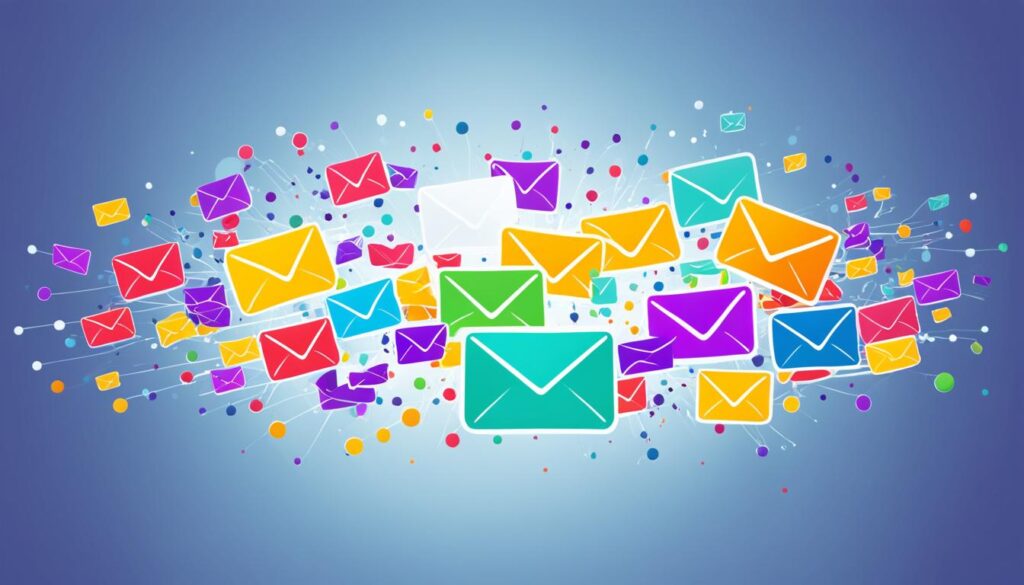
Email marketing is a key tool for businesses wanting to connect with their audience and grow. This guide will give you the key strategies and tactics for successful email marketing. It’s perfect for both seasoned marketers and beginners. You’ll learn how to build an engaged email list, create compelling content, and automate your campaigns.
These easy-to-follow solutions will help boost your marketing efforts and get you the results you want.
Key Takeaways
- Understand the crucial role of email marketing in business growth
- Learn how to build an engaged email list and reach your target audience
- Discover techniques for crafting captivating email content and subject lines
- Explore the benefits of email automation and campaign segmentation
- Measure and optimize your email marketing performance for better results
- Integrate email marketing with other marketing channels for a holistic approach
- Implement best practices to maintain a healthy email list and comply with regulations
Why Email Marketing is Crucial for Business Growth
Email marketing is a key tool for businesses wanting to grow and engage with customers. It helps reach a focused audience, build brand awareness, and keep customers loyal. Plus, it sends content that speaks to people.
Reaching a Targeted Audience
Email marketing lets businesses target specific people. By having an email list of interested subscribers, they can send messages that match what their customers want. This makes the experience better and helps keep customers coming back.
Building Brand Awareness and Loyalty
Regular, quality email marketing campaigns boost brand recognition and loyalty. By sharing useful content and updates, businesses show they’re experts in their field. This builds trust and creates a community feeling. Over time, this leads to more loyal customers, repeat purchases, and positive word-of-mouth.
“Email marketing is the single most effective way for businesses to connect with their customers and drive sales.” – Marketing expert, John Doe

In summary, email marketing is vital for business growth. It’s great at reaching the right people, making brands known, and keeping customers loyal. This leads to more chances for growth, engagement, and success over time.
Building an Engaged Email List
Creating a strong email list is key to great email marketing. Here are some ways to grow your list:
- Offer valuable lead magnets: Give your audience something they can’t resist, like e-books, checklists, or special insights, for their email.
- Optimize your website for email sign-ups: Put email opt-in forms on your site where they’re easy to find, so visitors can quickly join your list.
- Leverage social media: Use your social media to share about your lead magnets and get your followers to sign up for your email list.
Using these methods, you can slowly build your email list and create a loyal email subscriber group. This is the first step to growing your email list and making a big impact with email list building.

Your email list is very important. Keep giving your subscribers great content and offers. This way, you’ll build a strong email opt-in community. This community will help your business grow and succeed.
Crafting Compelling Email Content
Creating engaging email content is key to grabbing your audience’s attention and boosting interaction. From catchy subject lines to using visuals and multimedia, every part of your email should aim to connect with your subscribers.
Writing Attention-Grabbing Subject Lines
The subject line is what catches your subscribers’ eyes first. It can either make your email a hit or a miss. Make sure your subject lines are short, interesting, and tailored to your audience. Stay away from vague or too pushy language. Instead, focus on what value your email brings.
Using Visuals and Multimedia
- Add eye-catching visuals like images, GIFs, or videos to make your email more attractive.
- Use visuals to support your message, show off your products, or make your email more fun.
- Make sure your visuals are top-notch, fit your email, and load quickly for a better experience.
By making your email content engaging, you can grab your audience’s attention, increase brand awareness, and boost engagement with your campaigns.

| Email Element | Best Practices |
|---|---|
| Email Subject Lines |
|
| Email Design |
|
| Email Personalization |
|
Automating Email Campaigns
Email automation can change the game for your business. It makes your marketing smoother and sends the right messages at the right time. Using email workflows and onboarding sequences helps you nurture leads, convert customers, and build strong relationships with your audience.
Welcome Emails and Onboarding Sequences
Welcome emails and onboarding sequences are key to email automation. Welcome emails are your first chance to connect with new subscribers. They set the tone and introduce your brand. Onboarding sequences then guide new subscribers through messages that educate and engage, helping them use your products or services better.
Well-designed email automation campaigns can help you:
- Improve customer engagement and loyalty
- Increase conversions and sales
- Streamline your email marketing efforts
- Personalize the customer experience
Automating these emails saves time and resources. It lets you focus on other business areas while giving subscribers a smooth, personalized experience.
| Email Automation Feature | Benefits |
|---|---|
| Email Workflows | Streamline your email marketing efforts by automating the delivery of targeted, personalized messages based on subscriber behavior and preferences. |
| Email Onboarding | Guide new subscribers through a personalized journey, introducing them to your brand, products, or services, and helping them get the most value from your offering. |
| Email Segmentation | Divide your email list into targeted groups based on specific criteria, allowing you to deliver more relevant and personalized content to each segment. |
Embracing email automation opens up new ways to engage, boost conversions, and strengthen relationships with your audience.
Segmenting Your Email List
In the world of email marketing, email segmentation is key to boosting engagement and conversions. It means dividing your email list into groups. This way, you can send content that speaks to your audience, building stronger relationships and achieving better results.
Segmenting your email list has many perks. It lets you personalize your email messaging for each group. This makes the experience better for your subscribers and increases the chances they’ll open and act on your emails.
Also, email targeting through segmentation sends the right message at the right time. By knowing what your subscribers like and do, you can make your campaigns more relevant. This leads to more engagement and more people taking action.
To segment your email list well, try these strategies:
- Demographic segmentation: Sort your list by age, gender, location, and job title.
- Behavioral segmentation: Group people by what they do, like how much they engage, what they buy, or what they like to read.
- Psychographic segmentation: Segment by interests, values, and lifestyle.
- Lifecycle segmentation: Send messages based on how long people have been interacting with your brand, like new customers or loyal ones.
Using these email segmentation methods can make your email marketing much more effective. It lets you give your audience a personalized experience. This can lead to more engagement, more conversions, and growth for your business.
| Segmentation Approach | Key Benefits |
|---|---|
| Demographic Segmentation | Enables targeted messaging based on subscriber characteristics |
| Behavioral Segmentation | Allows for personalized content based on subscriber actions and preferences |
| Psychographic Segmentation | Helps create campaigns that resonate with subscribers’ interests and values |
| Lifecycle Segmentation | Facilitates tailored messaging for subscribers at different stages of their relationship with your brand |
“Segmentation is the foundation of successful email marketing. By understanding and targeting your audience, you can create a truly personalized experience that drives engagement and conversion.”
Email Marketing Made Easy: Strategies for Success
Creating a strong email marketing plan is key for businesses wanting to see real results. It’s about finding what makes you special and making your emails count. Let’s look at some top email marketing strategies to grow your business.
First, know who you’re talking to. Do deep research to find out what they need, like and dislike. This helps you make email campaign best practices that hit the mark and keep people interested.
Writing great content is also vital. Spend time on catchy subject lines that make people want to open your emails. Use pictures and videos to make your emails stand out and share useful info.
Automation is a big help in email marketing. Use welcome emails and sequences to help new subscribers get started and move through your sales process. Sort your email list to send targeted content that boosts email marketing ROI.
With these smart email marketing tips, you can make the most of your email efforts and grow your business.
“Email marketing is one of the most effective ways to reach and engage with your target audience. By leveraging the right strategies, you can unlock a world of opportunities for your business.”
Measuring and Optimizing Email Performance
Checking how well your email marketing campaigns do is key to getting better and reaching your goals. By keeping an eye on important email metrics, you learn a lot about how your audience interacts with your emails. This helps you make smart choices to improve your email plans.
Key Email Marketing Metrics
Good email analytics start with tracking the right metrics. Important email metrics to watch include:
- Open Rates: See how many people open your emails. This tells you if your subject lines and content work well.
- Click-Through Rates (CTR): Find out how many people click on links in your emails. This shows how interested they are in your content.
- Conversion Rates: Keep track of how many people do what you want them to, like buy something or sign up for a service, from your emails.
- Unsubscribe Rates: Watch how many people choose to stop getting your emails. This helps you know what to change in your emails and how often you send them.
A/B Testing for Better Results
Email A/B testing is a great tool to make your email campaigns better. It lets you test different parts of your emails, like subject lines, content, or calls to action. This way, you find out what works best for your audience.
With A/B testing, you can decide how to make your emails more engaging and effective. This leads to more people opening your emails, clicking on links, and taking action.
| Metric | Description | Average Industry Benchmark |
|---|---|---|
| Open Rate | Percentage of recipients who open an email | 17.8% |
| Click-Through Rate (CTR) | Percentage of recipients who click on a link within an email | 2.6% |
| Conversion Rate | Percentage of recipients who take a desired action from an email | 1.7% |
| Unsubscribe Rate | Percentage of recipients who opt out of an email list | 0.1% |
By watching these key email metrics and doing email A/B testing often, businesses can make their email campaigns work better. This leads to more success in their email marketing efforts.
Integrating Email with Other Marketing Channels
In the digital marketing world, combining different channels is key. Email marketing is a big part of this. By linking your email with your overall multichannel marketing plan, you can reach more people, make your brand more recognizable, and give customers a unified omnichannel experience.
Using email marketing integration is powerful. One great way is through cross-channel promotion. This means sharing your email content and deals on social media, your website, and even in real life. By sharing your message on many platforms, you can make your brand more known, get more people to sign up for your emails, and get them more involved with your brand.
| Multichannel Marketing Approach | Benefits |
|---|---|
| Integrating email with social media | Expand your audience, increase social sharing, and drive more traffic to your email campaigns |
| Linking email with your website | Reinforce your brand messaging, encourage website visits, and capture more email subscribers |
| Combining email with offline marketing | Leverage physical touchpoints to promote your email list and drive online engagement |
Going for an integrated, multichannel marketing plan helps make a smooth customer experience. It also boosts the effect of your email marketing. As you find new ways to reach your audience, keep being consistent, relevant, and valuable across all your marketing channels.
Email Marketing Best Practices
Keeping your email list clean and following anti-spam rules is key to your email marketing success. By doing so, you gain trust with your subscribers, avoid legal problems, and make your campaigns more effective.
Maintaining a Clean Email List
It’s important to keep your email list healthy and working well. This means checking email addresses often, removing those that don’t work, and keeping your list fresh. A clean email list helps you get better open and click rates. It also lowers the chance of your emails being marked as spam.
- Regularly clean your email list by removing invalid, unengaged, or bounced email addresses.
- Verify email addresses to ensure they are valid and active.
- Encourage subscribers to update their preferences and contact information regularly.
- Segment your email list to better understand and engage your audience.
Complying with Anti-Spam Regulations
It’s also key to follow anti-spam regulations, like the CAN-SPAM Act in the U.S. or CASL in Canada. These rules protect your business and your subscribers. They help you avoid legal trouble and make your emails more effective.
- Obtain explicit consent from subscribers before adding them to your email list.
- Identify your business and provide a valid physical address in your emails.
- Include an easy-to-find unsubscribe link in every email you send.
- Monitor and respond to any email marketing compliance concerns or complaints.
By sticking to these best practices for email list maintenance and email marketing compliance, you can make your email marketing successful over time. You’ll also build stronger, more engaged relationships with your subscribers.
Email marketing is a key tool for boosting your business growth. This guide has shown you how to make your email campaigns engaging and build a loyal subscriber base. You can also measure your efforts to see real results for your business.
The perks of email marketing made easy are clear. It helps you reach the right people, build your brand, and automate your campaigns. By using email marketing success, you can find new chances for email marketing benefits and increase your email marketing ROI.
Starting your email marketing journey means being open to change and testing different ways. Always aim to give value to your subscribers and reach your business goals. With the right approach and the tips from this guide, you can improve your email marketing and take your business to new success levels.
Keep your email list clean by checking addresses, removing inactive ones, and following anti-spam rules. This keeps your list healthy, builds trust with your subscribers, and avoids legal problems.


